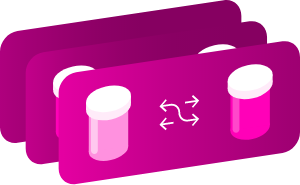Identification
- Summary
-
N-acetyltyrosineis an amino acid used in total parenteral nutrition.
- Brand Names
-
Aminosyn二世7 %, Sulfite-free, Trophamine 10 %
- Generic Name
- N-acetyltyrosine
- DrugBank Accession Number
- DB11102
- Background
-
N-acetyltyrosine, also referred to as N-acetyl-L-tyrosine, is used in place of as a tyrosine precursor.Tyrosine是一种非必需氨基酸,polar side group. N-acetyltyrosine is administered as parenteral nutrition or intravenous infusion due to its enhanced solubility compared to tyrosine2. It is typically administered as a source of nutritional support where oral nutrition is inadequate or cannot be tolerated.
- Type
- Small Molecule
- Groups
- Approved
- Structure
- Weight
-
Average: 223.2252
Monoisotopic: 223.084457909 - Chemical Formula
- C11H13NO4
- Synonyms
-
- (+)-(2s)-2-(acetylamino)-3-(4-hydroxyphenyl)propanoic acid
- (2s)-2-acetylamino-3-(4-hydroxyphenyl)propanoic acid
- Acetyl tyrosine
- L-N-acetyltyrosine
- Melanowhite-A
- N-acetyl-L-tyrosine
- N-acetyl-tyrosine
- N-acetyltyrosin
- External IDs
-
- 208-671-3
- NSC-10853
Pharmacology
- Indication
-
N-acetyltyrosine is indicated, in combination with several other amino acids and dextrose, as a peripherally administered source of nitrogen for nutritional support in patients with adequate stores of body fat in whom, for short periods, oral administration cannot be tolerated, is undesirable, or inadequateLabel.
It is also indicated, with other amino acids, 5-10% dextrose, and fat emulsion, for parenteral nutrition to preserve protein and reduce catabolism in stress conditions where oral administration is inadequateLabel.
When administered with other amino acids and concentrated dextrose, it is indicated for central vein infusion to prevent or reverse negative nitrogen balance in patients where the alimentary tract by the oral, gastrostomy, or jejestomy routes cannot or should not be used or in patients in which gastrointestinal absorption of protein is impaired, metabolic requirements for protein are substantially increased, or morbidity and mortality may be reduced by replacing amino acids lost from tissue breakdownLabel
 Reduce drug development failure ratesBuild, train, & validate machine-learning models
Reduce drug development failure ratesBuild, train, & validate machine-learning models
with evidence-based and structured datasets.Build, train, & validate predictive machine-learning models with structured datasets. - Contraindications & Blackbox Warnings
-
 Avoid life-threatening adverse drug eventsImprove clinical decision support with information oncontraindications & blackbox warnings, population restrictions, harmful risks, & more.Avoid life-threatening adverse drug events & improve clinical decision support.
Avoid life-threatening adverse drug eventsImprove clinical decision support with information oncontraindications & blackbox warnings, population restrictions, harmful risks, & more.Avoid life-threatening adverse drug events & improve clinical decision support. - Pharmacodynamics
-
N-acetyltyrosine is used as a high solubility precursor toTyrosineused due toTyrosine's poor solubility2. It is deacetylated to formTyrosine.
- Mechanism of action
-
Used as a source ofTyrosine. SeeTyrosinefor more information on its role and pharmacology.
- Absorption
-
Not Available
- Volume of distribution
-
Not Available
- Protein binding
-
Not Available
- Metabolism
- Not Available
- Route of elimination
-
N-acetyltyrosine is eliminated in the urine1. The extent of urinary elimination versus utilization in the tissues appears to be related to the rapidity of infusion. When infused slowly in standard doses as in the clinical setting, about 35% is excreted unchanged in the urine. When larger doses are infused rapidly, much higher amounts are excreted reaching values up to 56%3. In rat studies it was found that of the drug eliminated in the urine about 74% is present as unchanged N-acetyltyrosine and 23% is present as tyrosine2.
- Half-life
-
Not Available
- Clearance
-
Not Available
- Adverse Effects
-
 Improve decision support & research outcomesWith structured adverse effects data, including:blackbox warnings, adverse reactions, warning & precautions, & incidence rates.Improve decision support & research outcomes with our structured adverse effects data.
Improve decision support & research outcomesWith structured adverse effects data, including:blackbox warnings, adverse reactions, warning & precautions, & incidence rates.Improve decision support & research outcomes with our structured adverse effects data. - Toxicity
-
Not Available
- Pathways
- Not Available
- Pharmacogenomic Effects/ADRsBrowse all" title="" id="snp-actions-info" class="drug-info-popup" href="javascript:void(0);">
- Not Available
Interactions
- Drug InteractionsLearn More" title="" id="structured-interactions-info" class="drug-info-popup" href="javascript:void(0);">
-
This information should not be interpreted without the help of a healthcare provider. If you believe you are experiencing an interaction, contact a healthcare provider immediately. The absence of an interaction does not necessarily mean no interactions exist.
Drug Interaction Integrate drug-drug
interactions in your softwareAbacavir Abacavir马y decrease the excretion rate of N-acetyltyrosine which could result in a higher serum level. Aceclofenac Aceclofenac may decrease the excretion rate of N-acetyltyrosine which could result in a higher serum level. Acemetacin Acemetacin may decrease the excretion rate of N-acetyltyrosine which could result in a higher serum level. Acetaminophen Acetaminophen may decrease the excretion rate of N-acetyltyrosine which could result in a higher serum level. Acetazolamide Acetazolamide may increase the excretion rate of N-acetyltyrosine which could result in a lower serum level and potentially a reduction in efficacy. Acetylsalicylic acid Acetylsalicylic acid may decrease the excretion rate of N-acetyltyrosine which could result in a higher serum level. Aclidinium Aclidinium may decrease the excretion rate of N-acetyltyrosine which could result in a higher serum level. Acrivastine Acrivastine may decrease the excretion rate of N-acetyltyrosine which could result in a higher serum level. Acyclovir Acyclovir may decrease the excretion rate of N-acetyltyrosine which could result in a higher serum level. Adefovir dipivoxil Adefovir dipivoxil may decrease the excretion rate of N-acetyltyrosine which could result in a higher serum level.  Identify potential medication risksEasily compare up to 40 drugs with our drug interaction checker.Get severity rating, description, and management advice.了解更多
Identify potential medication risksEasily compare up to 40 drugs with our drug interaction checker.Get severity rating, description, and management advice.了解更多 - Food Interactions
- No interactions found.
Products
-
 Drug product information from 10+ global regionsOur datasets provide approved product information including:
Drug product information from 10+ global regionsOur datasets provide approved product information including:
dosage, form, labeller, route of administration, and marketing period.Access drug product information from over 10 global regions. - Mixture Products
-
Name Ingredients Dosage Route Labeller Marketing Start Marketing End Region Image Aminoplasmal Paed 10% Infusionslösung N-acetyltyrosine(1.3 g)+Acetylcysteine(0.7 g)+Alanine(15.9 g)+Arginine(9.1 g)+Aspartic acid(6.6 g)+Glutamic acid(9.3 g)+Glycine(2 g)+Histidine(4.6 g)+Isoleucine(5.1 g)+Leucine(7.6 g)+Lysine(8.8 g)+Methionine(2 g)+Phenylalanine(3.1 g)+Proline(6.1 g)+Serine(2 g)+Taurine(0.3 g)+Threonine(5.1 g)+Tryptophan(4 g)+Valine(6.1 g) Solution Parenteral B. Braun Melsungen Ag 2013-09-04 Not applicable Austria AMINOPLASMAL-10% E INFUSION N-acetyltyrosine(1 g/l)+Acetylcysteine(0.5 g/l)+Alanine(13.7 g/l)+Arginine(9.2 g/l)+Asparagine(3.27 g/l)+Aspartic acid(1.3 g/l)+Glutamic acid(4.6 g/l)+Glycine(7.9 g/l)+Histidine(5.2 g/l)+Isoleucine(5.1 g/l)+Leucine(8.9 g/l)+Lysine hydrochloride(5.6 g/l)+Magnesium acetate(0.56 g/l)+Malic acid(1.01 g/l)+Methionine(3.8 g / l)+Ornithine hydrochloride(2.51 g/l)+Phenylalanine(5.1 g/l)+Potassium acetate(2.45 g/l)+Proline(8.9 g/l)+Serine(2.4 g/l)+Sodium acetate(3.95 g/l)+Sodium hydroxide(0.2 g/l)+Sodium phosphate, monobasic(1.4 g/l)+Threonine(4.1 g/l)+Tryptophan(1.8 g/l)+Tyrosine(0.3 g/l)+Valine(4.8 g/l) Injection Intravenous B. BRAUN SINGAPORE PTE LTD 1991-05-13 Not applicable Singapore AMINOPLASMAL-5% E INFUSION N-acetyltyrosine(0.35 g / 1000毫升)+Acetylcysteine(0.25 g/1000ml)+Alanine(6.85 g/1000ml)+Arginine(4.6 g/1000ml)+Asparagine(1.64 g/1000ml)+Aspartic acid(0.65 g/1000ml)+Glutamic acid(2.3 g/1000ml)+Glycine(3.95 g/1000ml)+Histidine(2.6 g/1000ml)+Isoleucine(2.55 g/1000ml)+Leucine(4.45 g/1000ml)+Lysine hydrochloride(2.8 g/1000ml)+Magnesium acetate(0.56 g/1000ml)+Malic acid(1.01 g/1000ml)+Methionine(1.9 g/1000ml)+Ornithine hydrochloride(1.25 g/1000ml)+Phenylalanine(2.55 g/1000ml)+Potassium acetate(2.45 g/1000ml)+Proline(4.45 g/1000ml)+Serine(1.2 g/1000ml)+Sodium acetate(3.95 g/1000ml)+Sodium hydroxide(0.2 g/1000ml)+Sodium phosphate, monobasic(1.4 g/1000ml)+Threonine(2.05 g/1000ml)+Tryptophan(0.9 g/1000ml)+Tyrosine(0.3 g/1000ml)+Valine(2.4 g/1000ml) Injection Intravenous B. BRAUN SINGAPORE PTE LTD 1991-05-13 Not applicable Singapore Aminosyn二世 N-acetyltyrosine(270 mg / 100 mL)+Alanine(993 mg / 100 mL)+Arginine(1018 mg / 100 mL)+Aspartic acid(700 mg / 100 mL)+Glutamic acid(738 mg / 100 mL)+Glycine(500 mg / 100 mL)+Histidine(300 mg / 100 mL)+Isoleucine(660 mg / 100 mL)+Leucine(1000 mg / 100 mL)+Lysine acetate(1050 mg / 100 mL)+Methionine(172 mg / 100 mL)+Phenylalanine(298 mg / 100 mL)+Proline(722毫克/ 100毫升)+Serine(530 mg / 100 mL)+Threonine(400 mg / 100 mL)+Tryptophan(200 mg / 100 mL)+Valine(500 mg / 100 mL) Solution Intravenous Icu Medical Canada Inc 1987-12-31 Not applicable Canada Aminosyn二世 N-acetyltyrosine(270 mg/100mL)+Alanine(993 mg/100mL)+Arginine(1018毫克/ 100毫升)+Aspartic acid(700 mg/100mL)+Glutamic acid(738 mg/100mL)+Glycine(500 mg/100mL)+Histidine(300 mg/100mL)+Isoleucine(660 mg/100mL)+Leucine(1000 mg/100mL)+Lysine acetate(1050 mg/100mL)+Methionine(172 mg/100mL)+Phenylalanine(298 mg/100mL)+Proline(722 mg/100mL)+Serine(530 mg/100mL)+Threonine(400 mg/100mL)+Tryptophan(200 mg/100mL)+Valine(500 mg/100mL) Injection, solution Intravenous Icu Medical Inc. 2019-11-01 Not applicable US Aminosyn二世 N-acetyltyrosine(270 mg/100mL)+Alanine(993 mg/100mL)+Arginine(1018毫克/ 100毫升)+Aspartic acid(700 mg/100mL)+Glutamic acid(738 mg/100mL)+Glycine(500 mg/100mL)+Histidine(300 mg/100mL)+Isoleucine(660 mg/100mL)+Leucine(1000 mg/100mL)+Lysine acetate(1050 mg/100mL)+Methionine(172 mg/100mL)+Phenylalanine(298 mg/100mL)+Proline(722 mg/100mL)+Serine(530 mg/100mL)+Threonine(400 mg/100mL)+Tryptophan(200 mg/100mL)+Valine(500 mg/100mL) Injection, solution Intravenous Hospira, Inc. 2005-09-01 2017-12-01 US Aminosyn二世 N-acetyltyrosine(405 mg / 100 mL)+Alanine(1490 mg / 100 mL)+Arginine(1527 mg / 100 mL)+Aspartic acid(1050 mg / 100 mL)+Glutamic acid(1107 mg / 100 mL)+Glycine(750 mg / 100 mL)+Histidine(450 mg / 100 mL)+Isoleucine(990 mg / 100 mL)+Leucine(1500 mg / 100 mL)+Lysine acetate(1575 mg / 100 mL)+Methionine(258 mg / 100 mL)+Phenylalanine(447 mg / 100 mL)+Proline(1083 mg / 100 mL)+Serine(795 mg / 100 mL)+Threonine(600 mg / 100 mL)+Tryptophan(300 mg / 100 mL)+Valine(750 mg / 100 mL) Solution Intravenous Icu Medical Canada Inc 1995-12-31 Not applicable Canada Aminosyn二世 N-acetyltyrosine(405 mg/100mL)+Alanine(1490 mg/100mL)+Arginine(1527 mg/100mL)+Aspartic acid(1050 mg/100mL)+Glutamic acid(1107 mg/100mL)+Glycine(750 mg/100mL)+Histidine(450 mg/100mL)+Isoleucine(990 mg/100mL)+Leucine(1500 mg/100mL)+Lysine acetate(1575 mg/100mL)+Methionine(258 mg/100mL)+Phenylalanine(447 mg/100mL)+Proline(1083 mg/100mL)+Serine(795 mg/100mL)+Threonine(600 mg/100mL)+Tryptophan(300 mg/100mL)+Valine(750 mg/100mL) Injection, solution Intravenous Hospira, Inc. 1991-12-19 2023-12-01 US Aminosyn二世 N-acetyltyrosine(270 mg/100mL)+Alanine(993 mg/100mL)+Arginine(1018毫克/ 100毫升)+Aspartic acid(700 mg/100mL)+Glutamic acid(738 mg/100mL)+Glycine(500 mg/100mL)+Histidine(300 mg/100mL)+Isoleucine(660 mg/100mL)+Leucine(1000 mg/100mL)+Lysine acetate(1050 mg/100mL)+Methionine(172 mg/100mL)+Phenylalanine(298 mg/100mL)+Proline(722 mg/100mL)+Serine(530 mg/100mL)+Threonine(400 mg/100mL)+Tryptophan(200 mg/100mL)+Valine(500 mg/100mL) Injection, solution Intravenous Hospira, Inc. 1991-12-19 2013-09-01 US Aminosyn二世 N-acetyltyrosine(230 mg/100mL)+Alanine(844 mg/100mL)+Arginine(865 mg/100mL)+Aspartic acid(595 mg/100mL)+Glutamic acid(627 mg/100mL)+Glycine(425 mg/100mL)+Histidine(255 mg/100mL)+Isoleucine(561 mg/100mL)+Leucine(850 mg/100mL)+Lysine acetate(893 mg/100mL)+Methionine(146 mg/100mL)+Phenylalanine(253 mg/100mL)+Proline(614 mg/100mL)+Serine(450 mg/100mL)+Threonine(340 mg/100mL)+Tryptophan(170 mg/100mL)+Valine(425 mg/100mL) Injection, solution Intravenous Hospira, Inc. 2005-07-29 2017-06-01 US
Categories
- Drug Categories
- Chemical TaxonomyProvided byClassyfire
-
- Description
- This compound belongs to the class of organic compounds known as tyrosine and derivatives. These are compounds containing tyrosine or a derivative thereof resulting from reaction of tyrosine at the amino group or the carboxy group, or from the replacement of any hydrogen of glycine by a heteroatom.
- Kingdom
- Organic compounds
- Super Class
- Organic acids and derivatives
- Class
- Carboxylic acids and derivatives
- Sub Class
- Amino acids, peptides, and analogues
- Direct Parent
- Tyrosine and derivatives
- Alternative Parents
- Phenylalanine and derivatives/N-acyl-L-alpha-amino acids/Phenylpropanoic acids/Amphetamines and derivatives/1-hydroxy-2-unsubstituted benzenoids/Acetamides/Secondary carboxylic acid amides/Monocarboxylic acids and derivatives/Carboxylic acids/Organopnictogen compounds show 4 more
- Substituents
- 1-hydroxy-2-unsubstituted benzenoid/3-phenylpropanoic-acid/Acetamide/Amphetamine or derivatives/Aromatic homomonocyclic compound/Benzenoid/Carbonyl group/Carboxamide group/Carboxylic acid/Hydrocarbon derivative show 15 more
- Molecular Framework
- Aromatic homomonocyclic compounds
- External Descriptors
- L-tyrosine derivative, N-acetyl-L-amino acid (CHEBI:21563)
- Affected organisms
- Not Available
Chemical Identifiers
- UNII
- DA8G610ZO5
- CAS number
- 537-55-3
- InChI Key
- CAHKINHBCWCHCF-JTQLQIEISA-N
- InChI
-
InChI=1S/C11H13NO4/c1-7(13)12-10(11(15)16)6-8-2-4-9(14)5-3-8/h2-5,10,14H,6H2,1H3,(H,12,13)(H,15,16)/t10-/m0/s1
- IUPAC Name
-
(2 s)2-acetamido-3-(4-hydroxyphenyl)propanoic acid
- SMILES
-
CC(=O)N[C@@H](CC1=CC=C(O)C=C1)C(O)=O
References
- General References
-
- Hoffer LJ, Sher K, Saboohi F, Bernier P, MacNamara EM, Rinzler D: N-acetyl-L-tyrosine as a tyrosine source in adult parenteral nutrition. JPEN J Parenter Enteral Nutr. 2003 Nov-Dec;27(6):419-22. [Article]
- Im HA, Meyer PD, Stegink LD: N-acetyl-L-tyrosine as a tyrosine source during total parenteral nutrition in adult rats. Pediatr Res. 1985 Jun;19(6):514-8. [Article]
- Magnusson I, Ekman L, Wangdahl M, Wahren J: N-acetyl-L-tyrosine and N-acetyl-L-cysteine as tyrosine and cysteine precursors during intravenous infusion in humans. Metabolism. 1989 Oct;38(10):957-61. [Article]
- External Links
-
- Human Metabolome Database
- HMDB0000866
- PubChem Compound
- 68310
- PubChem Substance
- 347827896
- ChemSpider
- 61606
- BindingDB
- 50043802
- 31005
- ChEBI
- 21563
- ChEMBL
- CHEMBL65543
- ZINC
- ZINC000000156395
- PDBe Ligand
- 3NF
- PDB Entries
- 3nfz
- FDA label
-
Download (1 MB)
- MSDS
-
Download (35.9 KB)
Clinical Trials
- Clinical TrialsLearn More" title="" id="clinical-trials-info" class="drug-info-popup" href="javascript:void(0);">
-
Phase Status Purpose Conditions Count 3 Completed Treatment Infants, Premature/Low Birth Weight Infants/Newborn Infants/Sepsis/Small for Gestational Age Infants 1 2 Active Not Recruiting Treatment Carcinoid Tumors/Medulloblastomas/Neuroblastoma (NB)/Neuroendocrine Tumors 1 Not Available Completed Treatment Malignancies, Hematologic 1
Pharmacoeconomics
- Manufacturers
-
Not Available
- Packagers
-
Not Available
- Dosage Forms
-
Form Route Strength Solution Parenteral Injection Intravenous 0.5 g/l Injection Intravenous 0.25 g/1000ml Liquid Intravenous Injection, solution Intravenous Solution Intravenous - Prices
- Not Available
- Patents
- Not Available
Properties
- State
- Solid
- Experimental Properties
-
Property Value Source melting point (°C) 149-152 MSDS - Predicted Properties
-
Property Value Source Water Solubility 2.51 mg/mL ALOGPS logP 1.03 ALOGPS logP 0.59 Chemaxon logS -2 ALOGPS pKa (Strongest Acidic) 3.67 Chemaxon pKa (Strongest Basic) -2 Chemaxon Physiological Charge -1 Chemaxon Hydrogen Acceptor Count 4 Chemaxon Hydrogen Donor Count 3 Chemaxon Polar Surface Area 86.63 Å2 Chemaxon Rotatable Bond Count 4 Chemaxon Refractivity 56.54 m3·mol-1 Chemaxon Polarizability 22.25 Å3 Chemaxon Number of Rings 1 Chemaxon Bioavailability 1 Chemaxon Rule of Five Yes Chemaxon Ghose Filter Yes Chemaxon Veber's Rule No Chemaxon MDDR-like Rule No Chemaxon - Predicted ADMET Features
- Not Available
Spectra
- Mass Spec (NIST)
- Not Available
- Spectra
Drug created at December 03, 2015 16:51 / Updated at June 12, 2020 16:53




